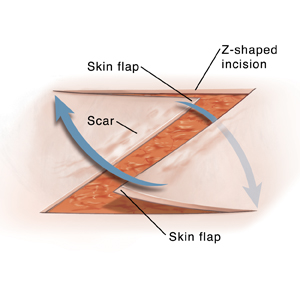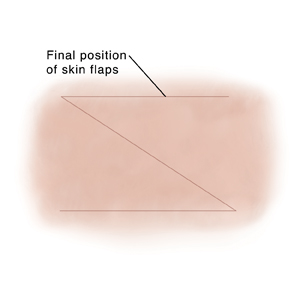Scar Revision: Z-Plasty
Scar Revision: Z-Plasty
A scar is a mark left after a wound has healed. In some cases, scar revision surgery can help improve the look of a scar or make it less visible. If the scar tissue is tight and restricts movement of the skin, revision can improve this. Z-plasty is a technique for scar revision. While this procedure is a commonly used plastic surgical technique, it may not be a good option for people with certain medical conditions or behaviors that affect blood flow to the skin. These include poorly controlled diabetes, prior skin irradiation, peripheral vascular disease, and smoking. Your healthcare provider will discuss risk factors with you before a surgical decision is made.
| |
|
Preparing for surgery
Prepare for the surgery as you have been told. In addition:
-
Tell your healthcare provider about all medicine you take. This includes herbs and other supplements. It also includes any blood thinners, such as warfarin, clopidogrel, or daily aspirin. You may need to stop taking some or all of them before surgery.
-
Do not eat or drink during the 8 hours before your surgery, or as directed by your healthcare provider. This includes coffee, water, gum, and mints. (If you have been instructed to take medicine, take them with a small sip of water.)
The day of surgery
The surgery takes 1 to 3 hours. You may go home the same day. Or you may stay 1 or more nights.
Before the surgery begins
-
An IV line may be put into a vein in your arm or hand. This line delivers fluids and medicines.
-
You will be given medicine (anesthesia) to keep you free of pain during the surgery. You may receive sedation. This medicine makes you relaxed and sleepy. Local anesthesia will be injected to numb the body parts to be worked on. In certain cases, general anesthesia is used instead. This puts you into a state like deep sleep during the surgery. With general anesthesia, a tube may be inserted into your throat to help you breathe. The anesthesiologist will discuss your options with you.
During the surgery
-
A Z-shaped incision is made through the scar tissue and some healthy skin. If the scar was very large, more than one Z-shaped incision may be made.
-
The Z-shape creates pointed flaps of skin. The pointed flaps of skin are arranged to break up the scar and lessen skin tightness. Once the flaps are in place, the incisions are closed with sutures (stitches). Some sutures may be placed under the skin and are absorbed later by your body.
-
The surgical site is covered with a bandage.
After the surgery
You will be taken to a recovery room to wake up from the anesthesia. You may feel sleepy and nauseated. If a breathing tube was used, your throat may be sore at first. You will be given medicine to manage any pain. If the revision is to a large area, you may stay one or more nights in the hospital. Once you are ready to go home, you will be released to an adult family member or friend.
Recovering at home
Once at home, follow the instructions you have been given. Your healthcare provider will tell you when you can return to your normal routine. During your recovery:
-
Take prescribed medicines exactly as instructed.
-
If advised by your healthcare provider, use a cold pack wrapped in a thin towel to relieve discomfort and control swelling. It’s important not to leave the cold pack on for too long, or your skin could be damaged. Put the pack over your bandages for no more than 10 minutes at a time. Then, leave it off for at least 20 minutes. Repeat this as often as needed during waking hours until swelling starts to improve.
-
Follow all instructions from your healthcare provider for taking care of the incision. Leave the bandage in place until you are told to remove or change it. Once you can change your bandage, do so every 24 hours or as directed. Also replace the bandage whenever it gets wet or dirty. Wash your hands before changing the bandage.
-
Follow your healthcare provider’s guidelines for showering. Avoid swimming, bathing, using a hot tub, and other activities that cause incisions to be covered with water until your healthcare provider says it’s OK. Don’t apply lotions, creams, or ointments to the area until after it is fully healed.
-
Avoid getting dirt or sweat on your incisions. If sutures get damp, pat them dry. Change your bandage if it gets wet or soiled.
-
Keep the skin moist and lubricated after it heals. Apply mineral oil or lotion daily for 3 to 4 months, or as your healthcare provider advises.
-
Avoid picking at scabs. They help protect the wound.
-
Avoid exposing the surgical area to the sun. Cover it when you go outside. When your healthcare provider says you can, use sunscreen on the area.
-
Avoid any exercise or movement that stretches the repaired skin until your healthcare provider says it’s OK. Talk to your healthcare provider about what movements are safe to do and which you should avoid during your recovery.
When to call the healthcare provider
Call the healthcare provider if you have any of the following:
-
A fever of 100.4°F (38°C) or higher, or as directed by your healthcare provider
-
Increased soreness, pain, or tenderness after 24 hours
-
A red streak, increased redness, or puffiness of the surgical site
-
White, yellowish, or bad-smelling discharge from an incision
-
Bleeding that doesnʼt stop when pressure is applied
-
Opening of the edges of an incision
Follow-up care
You will have follow-up visits so your healthcare provider can see how well you’re healing. If you have stitches that need to be removed, this will be done at one of these visits. Your healthcare provider will also check on the results of your surgery. Let your healthcare provider know if you have any questions or concerns.
Risks and complications
Risks and possible complications include:
-
Infection
-
Bleeding
-
Swelling
-
Not being happy with new scar appearance
-
Damage to nerves and blood vessels
-
Risks of anesthesia
Updated:
March 15, 2019
Sources:
Z-plasty. UpToDate
Reviewed By:
Fraser, Marianne, MSN, RN,Lickstein, David, MD

